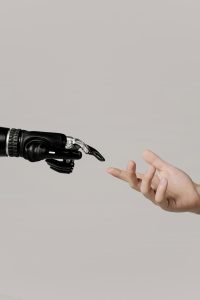6. Using Artificial Intelligence in the Workplace
Learning Objectives
In this chapter, you will learn how to:
- develop personalised strategies for effectively integrating artificial intelligence tools into your professional workflow while maintaining authenticity in your work
- apply artificial intelligence tools ethically and productively to enhance your professional capabilities without compromising academic or workplace integrity
- evaluate different approaches to artificial intelligence use across various professional contexts to determine appropriate applications for your field.
Imagine this Scenario
Sarah, Wei, and Priya started their summer internships at Horizon Solutions on the same Monday in June. All three were assigned to the product strategy team, tasked with analysing market opportunities and developing recommendations for clients. Their supervisor, James, gave them similar projects to start. Each needed to research emerging trends in their assigned industry sectors and prepare detailed reports with actionable insights. James also arranged for the interns to be given access to the company’s full suite of artificial intelligence tools and encouraged the students to use them.
Sarah embraced artificial intelligence tools with unbridled enthusiasm but little strategy. She would paste entire research briefs into AI assistants and accept the outputs without verification. While she turned in assignments remarkably quickly, her work often contained subtle but significant errors: misquoted statistics, outdated market data, and occasionally recommendations that didn’t align with the client’s actual capabilities. “I’m being efficient,” she would say when questioned, but her team members began double-checking all her numbers, which ultimately created more work.
Wei took the opposite approach. A self-proclaimed AI sceptic, he insisted on doing everything manually, from market research to data analysis to report writing. While his work was generally accurate, he consistently missed check-in deadlines and struggled to process the volume of information needed for comprehensive analysis. His productivity lagged notably behind his peers, and he often stayed late trying to catch up on work that could have been streamlined.
Priya developed what she called a “partnership approach” with AI tools. She learned to identify which tasks benefited from AI assistance (like initial data sorting and identifying patterns in large datasets) and which required human judgment and verification (like understanding client context and making strategic recommendations). She would use AI to generate initial drafts but always enhanced them with her own analysis and industry knowledge. Her process led to consistently high-quality work delivered on time, with original insights that went beyond surface-level analysis.

The differences became starkly apparent during their final report, a comprehensive analysis of the electric vehicle charging market. Sarah’s report, completed in record time, contained several outdated statistics and failed to account for recent regulatory changes. Wei produced thorough research but missed key market opportunities because he couldn’t process the vast amount of available data in time. Priya’s report struck the perfect balance, leveraging AI to process vast amounts of market data while applying her own critical thinking to develop nuanced, actionable recommendations.
By summer’s end, Priya’s balanced approach had not only improved her productivity significantly but also enhanced the quality of her analysis. Her integration of AI tools with human insight allowed her to take on additional projects while maintaining exceptional standards. She developed a reputation for delivering work that was both thorough and innovative, demonstrating that the future of professional work likely lies not in wholesale adoption or rejection of AI, but in learning to become what some called a “centaur”, combining the strengths of both human and machine intelligence.
As the internship program concluded, James reflected that Priya’s approach represented the future of professional work, neither blindly embracing nor rejecting new tools, but thoughtfully integrating them to enhance human capabilities. Her success showed that the key to effective AI use wasn’t just about access to the technology, but about developing the wisdom to know when and how to use it.
Developing an Approach to Using AI
Research by Dell’Acqua et al. (2023) on AI integration in professional settings reveals a fascinating phenomenon they call the “jagged technological frontier”, where AI’s capabilities vary dramatically across different tasks in sometimes surprising ways. Their study of 758 consultants at Boston Consulting Group demonstrated that thoughtful AI integration could increase productivity by 12.2% and improve work quality by over 40%, while misapplied AI could decrease performance by 19%. These findings are powerfully illustrated through the story of three interns, Sarah, Wei, and Priya, whose different approaches to AI integration mirror the patterns observed in the research. Just as Priya discovered through careful experimentation what the researchers would later quantify, the key to successful AI integration lies not in wholesale adoption or rejection, but in developing the wisdom to understand which tasks benefit from AI assistance and which require more direct human oversight. Like the high-performing consultants in the study, Priya’s “centaur” approach of strategically combining human and machine capabilities demonstrates how the future of professional work will likely depend on our ability to thoughtfully navigate this new technological frontier.
Summary of Dell’Acqua et al. (2023) The Jagged Frontier
Citation: Dell’Acqua, F., McFowland, E., III, Mollick, E. R., Lifshitz-Assaf, H., Kellogg, K., Rajendran, S., Krayer, L., Candelon, F., & Lakhani, K. R. (2023). Navigating the jagged technological frontier: Field experimental evidence of the effects of AI on knowledge worker productivity and quality (Harvard Business School Working Paper, No. 24-013). Harvard Business School. https://www.hbs.edu/faculty/Pages/item.aspx?num=64700
The research conducted by Dell’Acqua and colleagues represents one of the first large-scale studies examining how artificial intelligence, specifically Large Language Models (LLMs), affects the work of highly skilled professionals. Their study involved 758 consultants at Boston Consulting Group, representing approximately 7% of the firm’s individual contributor-level consultants. This significant sample size and the real-world nature of the tasks make their findings particularly valuable for understanding AI’s impact on knowledge work.
The researchers identified what they call a “jagged technological frontier” in AI capabilities, a key theoretical contribution to our understanding of AI integration in the workplace. This frontier isn’t smooth or predictable; instead, AI might excel at tasks that seem complex while struggling with others that appear simple. The researchers demonstrated this through carefully designed experiments where consultants completed both tasks within AI’s capabilities (like creative product development) and tasks just outside its frontier (like certain types of data analysis requiring subtle interpretation of qualitative information).
The results were striking: when working on tasks within AI’s capabilities, consultants using AI completed 12.2% more tasks and worked 25.1% faster than those without AI access. More importantly, the quality of their work improved dramatically, showing more than 40% higher quality compared to the control group. However, when tasks fell outside AI’s capabilities, consultants using AI were 19 percentage points less likely to produce correct solutions than those working without AI. This finding highlights the critical importance of understanding where tasks fall relative to AI’s capabilities.
Perhaps most intriguingly, the researchers identified two distinct patterns of successful AI integration. Some professionals adopted what they termed a “Centaur” approach, strategically dividing tasks between human and AI capabilities, much like the mythical creature that is half-human and half-horse. Others became “Cyborgs,” deeply integrating AI into their workflow with continuous interaction between human and machine. Both approaches proved effective when matched appropriately to the task at hand. The research also revealed that AI integration had the most dramatic impact on below-average performers, helping them improve by 43%, while top performers still saw a significant 17% improvement.
The implications of this research extend far beyond the consulting industry. The study suggests that organisations need to develop new frameworks for understanding AI capabilities, train employees in effective AI integration, and potentially redesign workflows to optimise human-AI collaboration. The researchers’ identification of the “jagged frontier” challenges simplistic notions about AI adoption and suggests that success with AI tools requires careful consideration of where and how they are deployed. This nuanced understanding of AI capabilities and limitations could help organisations avoid the pitfalls of both over-reliance and under-utilisation of AI tools while maximising their potential benefits.
The concept of the “jagged technological frontier” provides a useful framework for understanding how to integrate AI effectively in professional settings. As we know from the research, this uneven distribution of AI capabilities across different task types creates both opportunities and challenges.
The Boston Consulting Group study’s findings about the 40% quality improvement and 12.2% productivity increase among consultants who used AI thoughtfully reinforce why strategic integration matters. These metrics, combined with the concerning 19% decrease in performance when AI was misapplied, highlight the importance of developing nuanced judgment about AI tool usage.
Consider how these findings manifest in our three interns’ approaches. Sarah’s indiscriminate AI use exemplifies the pitfalls identified in the research when professionals operate beyond AI’s capabilities. Wei’s complete avoidance of AI illustrates the opportunity cost of missing the documented productivity gains. Priya’s approach aligns with the successful integration patterns identified in the research, demonstrating how understanding AI’s capability boundaries leads to optimal outcomes.
The research’s identification of “Centaur” and “Cyborg” patterns provides valuable models for professional AI integration. Priya’s strategic task division exemplifies the Centaur approach, while the Cyborg model offers an alternative path for deeper AI integration. Both patterns, as we know, require thoughtful consideration of AI’s evolving capabilities.

The study’s finding that below-average performers improved by 43% while top performers gained 17% has significant implications for workforce development. This differential impact suggests that thoughtful AI integration can serve as a powerful levelling mechanism while still benefiting high performers.
These insights fundamentally reshape our understanding of professional AI integration. Rather than viewing AI adoption as a binary choice, the research demonstrates the importance of developing what we might call “AI literacy” or, the ability to navigate this jagged frontier effectively. Success, as both the research and Priya’s example show, comes from understanding AI as a tool for augmenting human capabilities rather than replacing them.
The Three Types of AI Workers
Think of choosing your AI integration approach like choosing a transportation method. A non-user is like someone who only walks everywhere. They maintain complete control and independence, but might struggle to keep pace in situations where faster travel is expected. The research shows that while non-users avoid certain ethical complications, they often fall behind productivity benchmarks that assume some level of technological integration.
A Centaur approach is like someone who drives for specific trips but walks for others, making deliberate choices about when each mode serves them best. The Harvard and Boston Consulting Group study highlights both the benefits and risks here. While Centaurs can effectively leverage AI for specific tasks, their confidence in their AI usage sometimes exceeds their actual skill, leading to that concerning 19% error rate Dell’Acqua et. al. (2023) identified.

The Cyborg approach is like someone who uses various vehicles for every journey, a car, bike, scooter, depending on the specific need. While this comprehensive integration can significantly boost efficiency, it comes with higher stakes. Just as relying entirely on vehicles might leave you stranded if they break down, Cyborgs can experience heightened stress when AI tools don’t perform as expected.
To make this decision, consider asking yourself:
- What does your work primarily involve? Different fields may benefit more from different approaches.
- How comfortable are you with technological change? Cyborg approaches require constant adaptation.
- What are the consequences of errors in your work? The Harvard/BCG study’s findings about Centaur error rates might be more concerning in some fields than others.
- How important is independent skill maintenance in your profession? Some fields require maintaining strong non-AI capabilities.
Activity 6.1: Choosing Your AI Integration Path
This activity helps you explore different approaches to AI integration in professional settings, understand their implications, and make an informed decision about your preferred approach.
Part 1: Professional context analysis
Begin by examining your professional context.
Write a detailed response to these questions:
- “In my chosen profession…”
- What are the core tasks I perform daily?
- Which tasks require deep human judgment?
- Where do I see the most potential for AI assistance?
- What are the consequences of errors in my work?
- How important is maintaining independent skills?
Consider documenting your answers in a structured format, such as recreating the table below:
| Task Type | Current Approach | Potential for AI Integration |
Part 2: Role-play scenarios
Find two partners to explore each AI integration approach through role-play. Each person takes turns playing different roles while working through this scenario:
“Your team has been assigned a complex project requiring data analysis, creative problem-solving, and stakeholder communication. You have three weeks to complete it.”
Part 3: Decision making and reflection (10 minutes)
Based on your exploration, write a reflection addressing:
- Which approach best aligns with your:
- professional requirements
- personal work style
- risk tolerance
- learning preferences.
- What specific steps will you take to:
- develop necessary skills for your chosen approach
- mitigate identified risks
- maintain professional effectiveness
- adapt to changing technology.
- How might your approach need to evolve as:
- your career progresses
- AI capabilities change
- industry standards shift.
- Share your reflection with your group, discussing:
- How did others’ perspectives influence your decision?
- What concerns remain about your chosen approach?
- What resources might you need to implement your approach effectively?
💡Remember
There’s no universally “right” approach. The goal is to find the integration style that best serves your professional development and work requirements.
Using Artificial Intelligence Ethically in the Workplace
In today’s rapidly evolving workplace, the integration of artificial intelligence tools like ChatGPT has created both unprecedented opportunities and significant ethical challenges. While AI can dramatically enhance your efficiency and innovation, the manner in which organisations choose to implement and use these tools profoundly impacts their effectiveness and ethical implications. Their research identifies several key workplace applications where AI tools can provide meaningful support, including:
- data mining and analysis for research and operational insights
- language editing and enhancement of written communications
- generation of preliminary ideas and content drafts
- technical calculations and problem-solving in fields like engineering
- administrative task automation and streamlining
- real-time translation and cross-cultural communication support
- personalised learning content development for workplace training.
However, Griszbacher (2024) emphasises that the decision of how to approach AI implementation extends far beyond simply selecting appropriate software. It requires careful consideration of data privacy, bias mitigation, transparency, and the maintenance of human agency in decision-making processes. As AI becomes increasingly embedded in workplace operations, organisations must thoughtfully evaluate not just what AI tools to adopt, but how to implement them in ways that uphold professional integrity, protect employee wellbeing, and ensure responsible innovation. This makes the development of ethical AI usage frameworks a crucial priority for modern workplaces seeking to harness AI’s benefits while proactively addressing its risks.
As an intern entering a workplace, you’ll likely encounter various systems and policies governing the use of AI. Understanding these frameworks within your workplace is crucial for navigating your early career effectively. Most organisations now have structured approaches to AI implementation that directly affect how you’ll interact with these technologies in your daily work. For example, you might find that while AI helps analyse data or generate initial reports, your supervisor will always review AI-generated outputs with you, providing context and helping you understand how to interpret and use these insights effectively. This human oversight isn’t just a formality, it’s part of a carefully designed system ensuring that AI remains a tool to enhance your work rather than replace your professional judgment.
 You’ll also discover that many organisations have what’s known as “social contracts” regarding AI usage, essentially, clear guidelines about how AI should and shouldn’t be used in the workplace (Wright & Schultz, 2018). These policies are particularly important to you because they protect your interests while you’re developing your professional expertise. For instance, if AI tools are used to track your early performance or suggest training opportunities, you’ll have the opportunity to discuss these assessments with your managers and provide input. Most organisations will provide training about their AI systems during your onboarding, explaining not just how to use these tools but also the ethical considerations behind them. You might even be invited to participate in AI ethics committees or feedback sessions, giving you a voice in how these technologies are implemented in your workplace. This involvement can be a valuable opportunity to develop both your technical and leadership skills early in your career.
You’ll also discover that many organisations have what’s known as “social contracts” regarding AI usage, essentially, clear guidelines about how AI should and shouldn’t be used in the workplace (Wright & Schultz, 2018). These policies are particularly important to you because they protect your interests while you’re developing your professional expertise. For instance, if AI tools are used to track your early performance or suggest training opportunities, you’ll have the opportunity to discuss these assessments with your managers and provide input. Most organisations will provide training about their AI systems during your onboarding, explaining not just how to use these tools but also the ethical considerations behind them. You might even be invited to participate in AI ethics committees or feedback sessions, giving you a voice in how these technologies are implemented in your workplace. This involvement can be a valuable opportunity to develop both your technical and leadership skills early in your career.

Not every organisation has embraced artificial intelligence with open arms, and many organisations maintain restrictive policies around AI usage due to legitimate concerns about data security, privacy, and regulatory compliance. For interns entering these environments, understanding that these restrictions aren’t merely bureaucratic obstacles but often reflect serious considerations about protecting sensitive information, maintaining client confidentiality, and ensuring consistent quality control is crucial. Security concerns are particularly relevant in fields handling personal, financial, or proprietary data, where even seemingly harmless AI tools could potentially expose the organisation to significant risks (Jackson & Allen, 2024). Rather than viewing these policies as limitations, interns benefit from approaching them as important guardrails that protect both the organisation and its stakeholders.
Within these constraints, interns can still engage with AI ethically and professionally by focusing on approved tools and processes whilst maintaining transparent communication about their technology use. This involves being upfront with supervisors about AI tool preferences, clearly documenting any approved AI assistance usage, and ensuring all AI-supported work goes through appropriate review channels. For example, if a workplace allows AI for specific tasks like data analysis but prohibits it for client communications, respecting these boundaries absolutely whilst seeking opportunities to demonstrate the value of permitted AI use through careful documentation and quality results is essential. When uncertainty arises about whether an AI tool is appropriate for a particular task, seeking explicit guidance from supervisors rather than making assumptions represents the best approach. This commitment to transparency and respect for organisational policies helps build trust whilst positioning interns as professionals who can thoughtfully balance innovation with security requirements.
Activity 6.2: Navigating AI Implementation in Your Internship
Read the following scenario carefully:
Mateo has started his internship at TechnoCore Solutions, a medium-sized consulting firm. Throughout his university undergraduate studies, he frequently used AI tools to enhance his work and research projects. However, on his first day in Australia, he learns that TechnoCore has strict policies around AI usage: all AI-assisted work must be clearly documented, AI cannot be used for client communications, and all AI-generated content must undergo human review before being incorporated into any deliverables.
In his second week, Mateo’s supervisor assigns him a major data analysis project examining five years of client feedback to identify emerging trends and patterns. Looking at the sheer volume of data, Mateo realises this task would take several days of manual analysis, but he could complete it in just a few hours using AI tools he’s familiar with from university. He wants to make a good impression with efficient work, but he’s uncertain how to proceed under TechnoCore’s AI policies.
Later that week, after attending several project meetings, Mateo finds himself responsible for drafting the internal meeting summaries. He knows AI could help him create comprehensive summaries quickly, particularly useful since English is his second language. However, while reviewing the company’s AI policy documentation, he notices there’s no clear guidance about using AI for internal communications, leaving him unsure about the appropriate approach.
The situation becomes more complex when one of his colleagues, impressed by his data analysis work, suggests they use AI to help brainstorm solutions for a challenging client problem. “We don’t need to tell anyone since it’s just for initial ideas,” his colleague says with a wink. Mateo feels uncomfortable with this suggestion, remembering the strict policy about AI use in client-related work, but he also doesn’t want to damage this budding professional relationship.

Part 1: Navigating the scenarios:
- Consider the data analysis project. How could Mateo propose using AI tools for this task in a way that demonstrates both efficiency and respect for TechnoCore’s policies? Think about specific documentation and approval processes he might suggest to his supervisor.
- In the meeting summaries situation, where policy guidance is unclear, what principles should guide Mateo’s decision-making about AI use? Consider how his role as an intern and a non-native English speaker might influence this decision.
- When his colleague suggests using undisclosed AI for client work, how might Mateo maintain positive professional relationships while upholding ethical standards and company policies? Consider suggesting an alternative approach that achieves both goals.
- Looking across all three situations, how do they reflect the broader challenge of balancing technological efficiency with professional responsibility and organisational requirements? What consistent principles could Mateo apply when facing AI-related decisions?
- How might Mateo’s international background and previous experience with AI tools at university both help and hinder his navigation of TechnoCore’s AI policies? Consider how cultural differences in workplace norms and technology use might influence his approach.
Part 2: Professional email exercise
Task: Write a professional email from Mateo to his supervisor seeking clarification about AI usage for the data analysis project. This task will help develop skills in professional communication and ethical technology use.
Email writing guidelines:
- the email should demonstrate understanding of existing policies
- present a clear business case for AI usage in this specific context
- propose specific documentation and review processes
- maintain a professional yet collaborative tone
- show respect for organisational security considerations.
Here is a model email structure to guide your response:
Subject Line: Clarification Request: AI-Assisted Data Analysis for Client Feedback Project
Dear [Supervisor’s name],
First paragraph: Reference the assigned project and current status.
Second paragraph: Present the proposed AI approach and its benefits.
Third paragraph: Acknowledge company policies and suggest compliance measures.
Fourth paragraph: Request guidance and propose next steps
Your email should be approximately 200-250 words. Consider how to balance efficiency gains with policy compliance, and how to demonstrate professional judgment while seeking guidance as an intern.
After writing your email:
- Review it from your supervisor’s perspective. Have you provided all the information they need to make an informed decision?
- Consider what questions or concerns they might have and whether your email addresses these proactively.
- Evaluate whether your tone strikes the right balance between initiative and respect for organisational hierarchy.
Part 3: Reflecting on ethical AI usage
Write a reflective piece (approximately 300-400 words) addressing the following prompt:
Consider how your approach to using AI tools might evolve throughout your internship and early career. Drawing from Mateo’s situation, explore how you would develop your own framework for making decisions about AI use in professional settings.
Don’t forget the DIEP structure we encountered in Chapter 5. This may help you write your reflection in greater detail and clarity:
| Describe | Describe the event factually |
| Interpret | Interpret the event for its meaning and significance |
| Evaluate | Evaluate its importance |
| Plan | Plan for future scenarios |
Your reflection should consider:
Working with Artificial Intelligence on Internship
The story of Priya, Wei, and Sarah at the beginning of the chapter illustrates a key insight that aligns with Industry 5.0’s emphasis on human-machine collaboration. Just as Industry 5.0 seeks to create “symbiotic relationships between humans and machines” (Gamberini & Pluchino, 2024, p. 6), successful interns need to develop human-centric connected systems. During your internship, you will have a unique opportunity to experiment with finding this balance in a supported environment. Gamberini & Pluchino emphasise that Industry 5.0 focuses on “merging the creativity and expertise of human experts with efficient and intelligent machines” (2024, p. 5) rather than replacing humans with automation. This is exactly what Priya demonstrated in her approach. She didn’t just use AI tools blindly like Sarah or reject them entirely like Wei, but rather developed a nuanced understanding of how to leverage AI’s strengths while applying her own critical thinking and professional judgment.
An internship provides an ideal testing ground for developing these crucial capabilities. When interns like Priya experiment thoughtfully with AI tools, they aren’t just learning to use specific technologies, they’re developing skills such as curiosity, resilience, flexibility, agility, and systems thinking. These are precisely the attributes that are essential for adapting to changes brought about by automation and digitalisation. By practising this balanced approach during your internships, you can begin building the professional capabilities you’ll need throughout your career in an increasingly AI-enabled workplace.
Selecting AI Platforms for Professional Development
When beginning your journey with AI tools, the first step is selecting appropriate platforms that align with your professional needs. While numerous AI platforms exist, it’s important to approach platform selection strategically rather than attempting to master every available tool. Each platform has distinct strengths and capabilities that make it suitable for different professional tasks.
Currently, several major platforms dominate the professional landscape. OpenAI’s ChatGPT provides broad capabilities in text generation and analysis. Microsoft’s Copilot excels in both text and image generation tasks, making it particularly valuable for creative and visual projects. Google’s Bard offers strong capabilities in current events analysis and data interpretation. Anthropic’s Claude demonstrates strength in detailed analysis and precise writing tasks, especially valuable for professional documentation and research.

Rather than attempting to become proficient with every available platform, consider developing expertise with two or three that complement each other and align with your professional needs. For instance, you might pair a platform strong in visual generation (like Microsoft Copilot) with one specialising in detailed writing and analysis (like Claude). This approach allows you to develop deep proficiency with specific tools rather than surface-level familiarity with many.
When selecting your platforms, consider these factors:
- the specific requirements of your professional field
- the types of tasks you most commonly need to accomplish
- the platform’s reliability and accuracy for your use cases
- the platform’s ability to integrate with your existing workflow
- the platform’s approach to data privacy and security.
Remember that platform selection is not a permanent decision. As you develop experience and as the technology evolves, you may adjust your choices based on changing needs and capabilities. The goal is to build a toolkit that enhances your professional capabilities while maintaining your judgment and expertise as the guiding force in your work.
Bringing AI into Your Daily Professional Practice
Think of learning to work with AI like learning a new language. Immersion is key to developing fluency. Instead of reserving AI tools only for complex or challenging tasks, incorporate them into your regular workflow for routine activities. This approach serves two important purposes: it helps you develop comfort and competency with the tools while also helping the AI learn to match your professional communication style and standards.
Consider starting with straightforward professional communications. When booking travel for conferences or meetings, use AI to draft your initial emails to hotels and airlines. While you could certainly write these emails yourself, having AI generate a first draft gives you opportunities to refine its output and teach it your preferred tone and style. For instance, if the AI’s draft is too formal or casual, you can adjust it and use similar prompts in the future with notes about your preferred formality level.
Professional documentation provides another excellent opportunity for AI collaboration. When working with spreadsheets, instead of immediately searching online for formula solutions, engage with AI to help construct them. This process not only helps you complete the immediate task but also builds your understanding of formula logic through the AI’s explanations. You might ask the AI to explain its thought process or suggest alternative approaches, turning each interaction into a learning opportunity.

Discussion forums and professional networking platforms offer particularly valuable opportunities to develop your AI collaboration skills. Rather than simply using AI to generate responses, engage with it as a thought partner. Share your initial ideas and ask the AI to help you refine them or consider different perspectives. This approach helps you maintain your authentic voice while leveraging AI’s ability to suggest enhancements or identify areas that might benefit from clarification.
The key is to view these everyday interactions as training opportunities, both for yourself and the AI. Each time you refine an AI-generated draft or adjust its tone to better match your professional style, you’re developing your ability to effectively collaborate with these tools while teaching them to better serve your needs. Think of it as developing a professional partnership rather than simply using a tool.
Building an Effective Partnership with AI
The key to productive AI collaboration lies in understanding that these systems are designed to engage in natural, conversational interactions. Just as clear communication and professional courtesy enhance human workplace relationships, they also improve the quality of AI interactions. When we frame our requests with clarity, context, and courtesy, we create conditions for more precise and useful AI responses.
Consider how you would approach a knowledgeable colleague for assistance. You wouldn’t simply demand information, you would provide context, explain your needs, and frame your request respectfully. The same principle applies to AI interactions. Instead of issuing abrupt commands like “Write hotel email,” take a moment to set the stage with context and specific parameters. For example: “I need to write a professional email to confirm my hotel booking for a business conference. The booking is for three nights starting July 15th at the Marriott downtown. Could you help me draft an email that’s courteous and includes all essential details?” This approach gives the AI the context it needs to generate more relevant and useful responses.
 This principle extends beyond simple task requests. When working on complex projects, treat the AI as a collaborative partner by sharing your thought process and objectives. For example, when starting a data analysis project, you might say: “I’m analysing customer feedback data to identify trends in product satisfaction. Could you help me think through effective approaches to categorising this data? I’d particularly like to focus on identifying recurring themes in the comments.” By providing this level of context and engaging in a more collaborative dialogue, you enable the AI to provide more targeted and valuable assistance while maintaining your role as the decision-maker guiding the process.
This principle extends beyond simple task requests. When working on complex projects, treat the AI as a collaborative partner by sharing your thought process and objectives. For example, when starting a data analysis project, you might say: “I’m analysing customer feedback data to identify trends in product satisfaction. Could you help me think through effective approaches to categorising this data? I’d particularly like to focus on identifying recurring themes in the comments.” By providing this level of context and engaging in a more collaborative dialogue, you enable the AI to provide more targeted and valuable assistance while maintaining your role as the decision-maker guiding the process.
Learning Together: The Feedback Loop in AI Collaboration
Effective AI collaboration requires developing a two-way learning relationship where feedback plays a crucial role in improving outcomes. Just as you would help a new colleague understand your preferences and standards, providing constructive feedback to AI helps refine its responses to better match your professional needs. This feedback process isn’t just about correcting mistakes, it’s about guiding the AI to better understand the nuances of your requirements and professional context.
Consider how feedback works in professional mentoring relationships: specific, constructive comments help people understand not just what to change, but why the change matters. The same principle applies when working with AI. Instead of simply accepting or rejecting outputs, engage in a dialogue about refinements. For example, if an AI generates a client report that’s technically accurate but too informal, you might say: “The analysis is thorough, but could you revise this using more professional language appropriate for senior executives? In particular, I’d like to see more industry-specific terminology and a more formal tone.” This specific guidance helps the AI understand the professional standards you’re aiming to meet.
 Remember that feedback works best when it’s:
Remember that feedback works best when it’s:
- specific about what works and what needs improvement
- constructive rather than simply critical
- focused on the desired outcome
- clear about the professional context and standards
- building toward better future interactions.
For instance, you might say: “The structure of this analysis is excellent, particularly how you’ve organised the key findings. However, could you enhance the recommendations section by including more specific, actionable steps? Our clients typically expect detailed implementation guidance.” This type of feedback not only improves the current output but helps the AI better understand your professional needs for future interactions.
By consistently providing thoughtful feedback, you help create a more effective working relationship with AI tools while developing your own skills in professional communication and quality assessment. This feedback loop becomes an integral part of your professional development, helping you refine both your use of AI tools and your ability to articulate professional standards and expectations.
Activity 6.3: Developing Your AI Partnership Strategy
This activity helps you develop practical experience working with AI tools in a professional context, learning how to effectively integrate AI assistance into your workflow while maintaining professional judgment and standards.
Part 1: Platform selection and setup
Choose two AI platforms to work with during your internship. Write a brief paragraph explaining why you selected these platforms, considering:
- what specific professional tasks you plan to accomplish
- how these platforms complement each other
- any limitations or considerations that influenced your choice.
Part 2: Initial experimentation
Create three different versions of a professional email requesting information about potential internship opportunities in your field. This exercise helps you understand how different approaches to AI collaboration affect outcomes.
Version 1: Write the email entirely by yourself, without AI assistance
Version 2: Use AI to generate the complete email
Version 3: Use a collaborative approach where you:
- prime the AI with context about your background and goals
- request an initial draft
- provide feedback for improvements
- work together to refine the final version.
Compare these three versions, analysing:
- the strengths and weaknesses of each approach
- how well each version reflects your professional voice
- the time invested in each method
- the quality of the final product.
Part 3: Week-long implementation challenge
Over the next week, maintain a “Partnership journal” documenting your AI interactions.
For each day:
Sample Journal Entry:
Part 4: Peer discussion and analysis
At the end of the week, share with someone else who completed this activity and discuss:
- What surprised you about working with AI?
- Which tasks benefited most from AI collaboration?
- How did your approach to AI interaction evolve over the week?
- What best practices did you develop?
- How might these lessons apply to your future career?
💡Remember
The goal isn’t to maximise AI usage but to develop thoughtful, effective patterns of human-AI collaboration that enhance your professional capabilities while maintaining your judgment and expertise as the guiding force in your work.
Key Takeaways
In this chapter, we covered:
- how successful AI integration requires a balanced “partnership approach” where professionals strategically use AI tools while maintaining human judgment, as research demonstrates this can improve work quality by up to 40% while avoiding the performance decreases associated with over-reliance.
- how developing proficiency with AI requires systematic practice starting with everyday professional tasks, like language immersion, allowing professionals to build competence gradually before tackling more complex applications.
- how organisational AI policies serve as essential safeguards for data security, privacy and regulatory compliance, requiring professionals to understand and respect these guidelines while finding ways to innovate responsibly within established frameworks.
- how effective AI collaboration requires treating AI systems as professional partners by providing clear context, specific guidance, and constructive feedback, enabling more precise and valuable AI assistance while maintaining professional standards.
- how successful professionals in the AI era become “centaurs” by thoughtfully combining human and machine capabilities, developing both technical skills with AI tools and essential meta-competencies like critical thinking and professional judgment.
References
Dell’Acqua, F., McFowland, E., III, Mollick, E. R., Lifshitz-Assaf, H., Kellogg, K., Rajendran, S., Krayer, L., Candelon, F., & Lakhani, K. R. (2023). Navigating the jagged technological frontier: Field experimental evidence of the effects of AI on knowledge worker productivity and quality (Harvard Business School Working Paper, No. 24-013). Harvard Business School. https://www.hbs.edu/faculty/Pages/item.aspx?num=64700
Gamberini, L., & Pluchino, P. (2024). Industry 5.0: A comprehensive insight into the future of work, social sustainability, sustainable development, and career. Australian Journal of Career Development, 33(1), 5–14. https://doi.org/10.1177/10384162241231118
Griszbacher, N. (2024). Delving into chit-chat with GPT-3.5: Holy Grail or Pandora’s Box? : A review of AI opportunities and challenges in academia. GILE Journal of Skills Development, 4(1), 4–29. https://doi.org/10.52398/gjsd.2024.v4.i1.pp4-29
Jackson, D., & Allen, C. (2024). Enablers, barriers and strategies for adopting new technology in accounting. International Journal of Accounting Information Systems, 52, Article 100666. https://doi.org/10.1016/j.accinf.2023.100666
Wright, S. A., & Schultz, A. E. (2018). The rising tide of artificial intelligence and business automation: Developing an ethical framework. Business Horizons, 61(6), 823–832. https://doi.org/10.1016/j.bushor.2018.07.001
Media Attributions
- Code projected over woman © ThisIsEngineering, available under a Pexels licence
- A robot holding a flower © Pavel Danilyuk, available under a Pexels licence
- Man and Woman Shaking Hands © Yaroslav Shuraev, available under a Pexels licence
- Hand of a Person and a Bionic Hand © cottonbro studio, available under a Pexels licence
- White Caution Cone on Keyboard © Fernando Arcos, available under a Pexels licence
- Close-Up of Laptop Screen Displaying ChatGPT Introduction © Beyzaa Yurtkuran, available under a Pexels licence
- A person holding a cell phone in their hand © Solen Feyissa, available under an Unsplash licence
- Black and white robot toy on red wooden table © Andrea De Santis, available under an Unsplash licence
- Close-Up Shot of Fist Bump © cottonbro studio, available under a Pexels licence
- Man in White Crew-neck Top Reaching for the Like © Oladimeji Ajegbile, available under a Pexels licence

